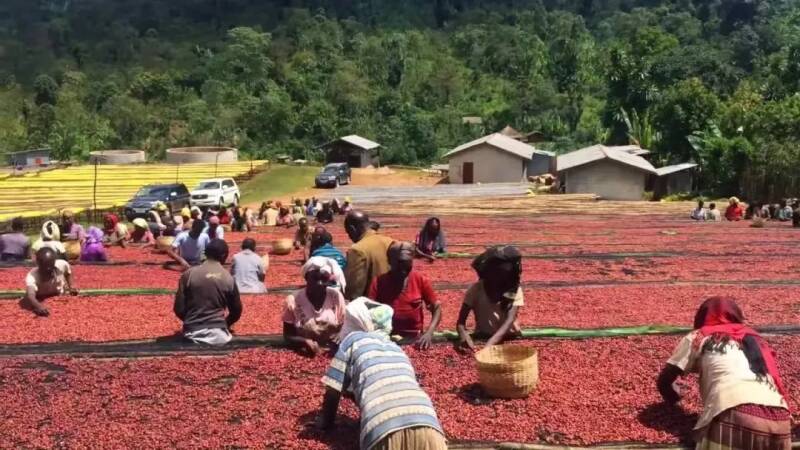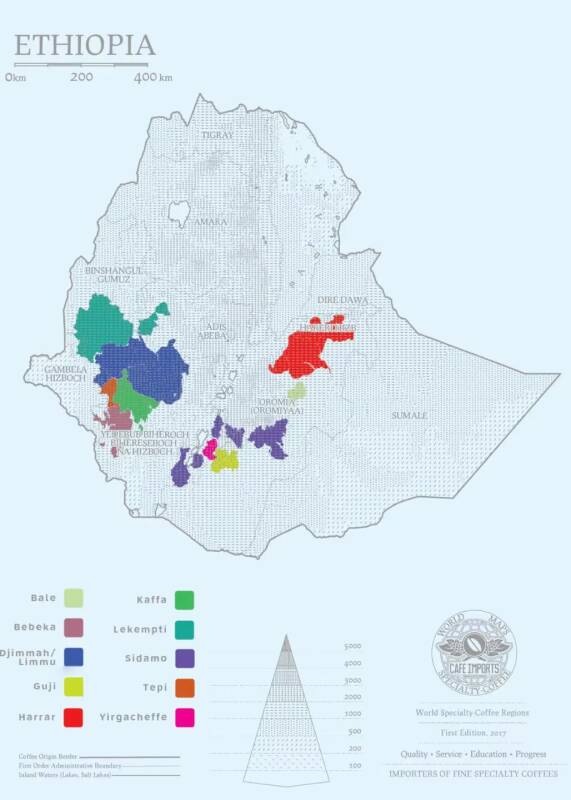Colombia's coffee industry has been greatly affected by civil strife and foreign invasion
Ethiopia is a mecca for coffee lovers. It is the birthplace of coffee and is now the largest Arabica coffee producer in Africa. It also has the largest coffee gene pool in the world, with a wide variety of coffee, and it is estimated that there are now nearly 15000 coffee varieties in Ethiopia.
Ethiopia
Ethiopia is located on the East African Plateau southwest of the Red Sea, bordering Djibouti, Somalia, Sudan, South Sudan, Kenya and Eritrea. The territory is dominated by mountainous plateaus, most of which belong to the Ethiopian plateau, and the central and western regions are the main body of the plateau, accounting for 2ax 3 of the country. And the East African Rift Valley runs through the whole territory, with an average elevation of nearly 3000 meters above sea level.

The average altitude in Ethiopia is 2450 meters above sea level, which makes the annual average temperature in Ethiopia 16 ℃, which is roughly divided into dry season and rainy season, with annual rainfall of 1237 mm. The country is rich in natural resources, rich in water resources, high-altitude mountains and more than 50 volcanoes, which make the country an ideal area for coffee cultivation. In Ethiopia, coffee is grown on a large scale, mainly courtyard coffee. Coffee and other crops are grown near the farmers' homes, taken care of by the farmers on a daily basis, collected by themselves during the harvest season, and then collected and processed by middlemen or treatment stations. This model accounts for more than half of Ethiopia's total coffee production.
Yega Xuefei Yirgacheffe
Ethiopia has many famous coffee producing areas, such as Sidamo, Jima, Haller, Guji and Yirgacheffe, among which Guji and Yirgacheffe originally belonged to Sidamo, but became an independent coffee producing area because of their unique flavor.

Yegashafi is a small town northwest of Sidamo Province, located on the eastern edge of the East African Rift Valley. It is also one of the highest altitude producing areas in Ethiopia, at an altitude of 1750-2200 meters. In ancient Chinese, Yirga means to settle down, while Cheffe means wetlands. Because of its mild and humid climate, abundant rainfall, fertile land and plenty of sunlight, the area can give birth to unique aromas of flowers and fruit, unpredictable and unique flavor of coffee beans. Qianjie Coffee has a washed Ethiopian Yejasuffi coffee bean, as an entry selection, with jasmine, lemon-like acidity, orange, berries and other fruit flavor, refreshing taste.
Red Cherry Project ORC
Before there is no introduction to fine coffee, in order to earn more benefits, farmers do not care about the quality of coffee cultivation and only focus on output, and when it comes to harvest time, they will not care whether the berries are ripe or not, so the final coffee beans have a poor flavor. It was not until 2007 that Trabocca, a Dutch raw bean maker, put forward the "Red Cherry Project" (ORC).
First, the Dutch raw bean merchant first invited all farms in Ethiopia to produce small batches of beans of about 1500-3000 kilograms, requiring the beans to be made from ripe red fruit manually. Then it is buying at a price several times higher than the market. As a result, although more manpower and capital investment are needed in harvesting, selection and disposal, the income of farmers has increased, and so has the price of raw coffee beans. But not all raw beans will be bought at a high price by Trabocca. Trabocca also chooses from them and needs to get cup test standards from offices in Ethiopia and the Netherlands. To sum up, Red Cherry plans to increase the purchase price of high-quality coffee raw beans to encourage farmers to complete every process of collecting and processing coffee berries, so that the coffee beans produced are of better quality and taste, and are recognized by the market at the same time. Get a relatively high purchase price. At present, the main producing areas of the red cherry project are Yega Sheffield, Sidamo, Penga Forest, Lekanti, Ken Bata, Hara, Lim and so on.
Qianjie coffee Ethiopia Yega Xuefei sun red cherry coffee bean production area: Yega Xuefei production area altitude: 1700-2200 m varieties: original species Heirloom treatment method: sun treatment flavor: berries lemon fermented fruit fragrant strawberries
The Ethiopian Yega Snow Red Cherry Coffee beans bought from Qianjie Coffee are sun-treated and lightly roasted. In front of the street, the proportion of V60Graz is 15, and the water temperature is 92 ℃. It will smell slightly fermented fruit, fresh lemon acidity, berry and strawberry flavor, and refreshing taste.
Important Notice :
前街咖啡 FrontStreet Coffee has moved to new addredd:
FrontStreet Coffee Address: 315,Donghua East Road,GuangZhou
Tel:020 38364473
- Prev

Is cold extract coffee good with milk? Introduction of the correct powder/water ratio and preparation method of cold brewed coffee
Open the weather forecast in the phone, full screen 30 degrees high temperature, this time, summer and scorching heat really come! Everyone hurry up and set up all kinds of iced coffee!! The most popular home iced coffee, cold extract (cold bubble) must be on the list. Soak a pot before bed, throw it in the fridge, and wake up and filter it
- Next

The bean latte arrived late! Flower Kui said he was innocent.
▲ Click attention| A few years ago, bean juice dirty in Shanghai International Coffee Food Culture Festival "stunning"the audience, not only opened the eyes of netizens, but also brought a strong impact on taste buds. After years of development, the coffee was a coffee.
Related
- Detailed explanation of the proportion of gold gouache in hand-brewed coffee? What are the Gold Cup Guidelines?
- What is the difference between the gold label rose summer and the red label rose summer in Guixia Village? Are Rose Summer 1931 and Gori Rose Summer?
- Cudi stores ban other brands of coffee?! Netizen: No problem
- Is it better to make coffee cold or hot? Why is it recommended to drink hot coffee?
- Lucky people collapsed! The store ceiling is full of AI surveillance cameras?!
- Law Enforcement Bureau? Mixue Ice City enters Zhengzhou BRT platform!
- Heavy! Nestlé has been exposed to consider selling blue bottle coffee!
- Compensation of 270 million yuan! Starbucks has been charged with violating labor laws more than 500,000 times!
- What are Xizhao coffee beans? Why did they become champion beans? How to rush to the manor on the dividing line in Colombia?
- What does channel effect mean in coffee? Why are there holes in the coffee powder cake?

